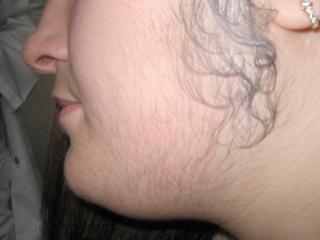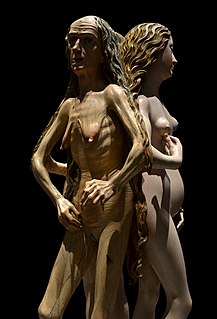Related Research Articles

Dehydroepiandrosterone (DHEA), also known as androstenolone, is an endogenous steroid hormone precursor. It is one of the most abundant circulating steroids in humans. DHEA is produced in the adrenal glands, the gonads, and the brain. It functions as a metabolic intermediate in the biosynthesis of the androgen and estrogen sex steroids both in the gonads and in various other tissues. However, DHEA also has a variety of potential biological effects in its own right, binding to an array of nuclear and cell surface receptors, and acting as a neurosteroid and modulator of neurotrophic factor receptors.

Polycystic ovary syndrome, or PCOS, is the most common endocrine disorder in women of reproductive age. The syndrome is named after the characteristic cysts which may form on the ovaries, though it is important to note that this is a sign and not the underlying cause of the disorder.

Hirsutism is excessive body hair on parts of the body where hair is normally absent or minimal. The word is from early 17th century: from Latin hirsutus meaning "hairy". It may refer to a "male" pattern of hair growth that may be a sign of a more serious medical condition, especially if it develops well after puberty. Cultural stigma against hirsutism can cause much psychological distress and social difficulty. Discrimination based on facial hirsutism often leads to the avoidance of social situations and to symptoms of anxiety and depression.

Antiandrogens, also known as androgen antagonists or testosterone blockers, are a class of drugs that prevent androgens like testosterone and dihydrotestosterone (DHT) from mediating their biological effects in the body. They act by blocking the androgen receptor (AR) and/or inhibiting or suppressing androgen production. They can be thought of as the functional opposites of AR agonists, for instance androgens and anabolic steroids (AAS) like testosterone, DHT, and nandrolone and selective androgen receptor modulators (SARMs) like enobosarm. Antiandrogens are one of three types of sex hormone antagonists, the others being antiestrogens and antiprogestogens.
Adrenarche is an early stage in sexual maturation that happens in some higher primates and in humans, typically peaks at around 20 years of age, and is involved in the development of pubic hair, body odor, skin oiliness, axillary hair, sexual attraction/sexual desire/increased libido and mild acne. During adrenarche the adrenal glands secrete increased levels of weak adrenal androgens, including dehydroepiandrosterone (DHEA), dehydroepiandrosterone sulfate (DHEA-S), and androstenedione (A4), but without increased cortisol levels. Adrenarche is the result of the development of a new zone of the adrenal cortex, the zona reticularis. Adrenarche is a process related to puberty, but distinct from hypothalamic–pituitary–gonadal axis maturation and function.

Ketoconazole, sold under the brand name Nizoral among others, is an antiandrogen and antifungal medication used to treat a number of fungal infections. Applied to the skin it is used for fungal skin infections such as tinea, cutaneous candidiasis, pityriasis versicolor, dandruff, and seborrheic dermatitis. Taken by mouth it is a less preferred option and only recommended for severe infections when other agents cannot be used. Other uses include treatment of excessive hair growth and Cushing's syndrome.

Hyperplasia, or hypergenesis, is an enlargement of an organ or tissue caused by an increase in the amount of organic tissue that results from cell proliferation. It may lead to the gross enlargement of an organ, and the term is sometimes confused with benign neoplasia or benign tumor.

Hyperandrogenism is a medical condition characterized by high levels of androgens. It is more common in women than men. Symptoms of hyperandrogenism may include acne, seborrhea, hair loss on the scalp, increased body or facial hair, and infrequent or absent menstruation. Complications may include high blood cholesterol and diabetes. It occurs in approximately 5% of women of reproductive age.

Flutamide, sold under the brand name Eulexin among others, is a nonsteroidal antiandrogen (NSAA) which is used primarily to treat prostate cancer. It is also used in the treatment of androgen-dependent conditions like acne, excessive hair growth, and high androgen levels in women. It is taken by mouth, usually three times per day.

Dehydroepiandrosterone sulfate, abbreviated as DHEA sulfate or DHEA-S, also known as androstenolone sulfate, is an endogenous androstane steroid that is produced by the adrenal cortex. It is the 3β-sulfate ester and a metabolite of dehydroepiandrosterone (DHEA) and circulates in far greater relative concentrations than DHEA. The steroid is hormonally inert and is instead an important neurosteroid and neurotrophin.
Hyperthecosis, or ovarian hyperthecosis, is hyperplasia of the theca interna of the ovary. Hyperthecosis occurs when an area of luteinization occurs along with stromal hyperplasia. The luteinized cells produce androgens, which may lead to hirsutism and virilization in affected women.

Cyproterone acetate (CPA), sold alone under the brand name Androcur or with ethinylestradiol under the brand names Diane or Diane-35 among others, is an antiandrogen and progestin medication used in the treatment of androgen-dependent conditions such as acne, excessive body hair growth, early puberty, and prostate cancer, as a component of feminizing hormone therapy for transgender women, and in birth control pills. It is formulated and used both alone and in combination with an estrogen. CPA is taken by mouth one to three times per day.

Benorterone, also known by its developmental code name SKF-7690 and as 17α-methyl-B-nortestosterone, is a steroidal antiandrogen which was studied for potential medical use but was never marketed. It was the first known antiandrogen to be studied in humans. It is taken by mouth or by application to skin.
An estrogen-dependent condition, disease, disorder, or syndrome, is a medical condition that is, in part or full, dependent on, or is sensitive to, the presence of estrogenic activity in the body.

Breast atrophy is the normal or spontaneous atrophy or shrinkage of the breasts.
A steroidogenesis inhibitor, also known as a steroid biosynthesis inhibitor, is a type of drug which inhibits one or more of the enzymes that are involved in the process of steroidogenesis, the biosynthesis of endogenous steroids and steroid hormones. They may inhibit the production of cholesterol and other sterols, sex steroids such as androgens, estrogens, and progestogens, corticosteroids such as glucocorticoids and mineralocorticoids, and neurosteroids. They are used in the treatment of a variety of medical conditions that depend on endogenous steroids.

A steroidal antiandrogen (SAA) is an antiandrogen with a steroidal chemical structure. They are typically antagonists of the androgen receptor (AR) and act both by blocking the effects of androgens like testosterone and dihydrotestosterone (DHT) and by suppressing gonadal androgen production. SAAs lower concentrations of testosterone through simulation of the negative feedback inhibition of the hypothalamus. SAAs are used in the treatment of androgen-dependent conditions in men and women, and are also used in veterinary medicine for the same purpose. They are the converse of nonsteroidal antiandrogens (NSAAs), which are antiandrogens that are not steroids and are structurally unrelated to testosterone.

HAIR-AN syndrome consists of hyperandrogenism (HA), insulin resistance (IR) and acanthosis nigricans (AN). It is a rare disease which is a subset of polycystic ovary syndrome (PCOS). Polycystic ovary syndrome is a condition in females in which there is an increase in the production of androgen, leading to an expression of male-like characters in the female body. The name HAIR-AN is made up of the three conditions of which it consists. The commonly used term "HAIR-AN" is a generic description of the features of SIR ." Although HAIR-AN can result from two very different types of abnormalities – blocking antibodies against the insulin receptor or genetically absent/reduced insulin receptor number/function – patients with both types have high levels of androgens.
The medical uses of bicalutamide, a nonsteroidal antiandrogen (NSAA), include the treatment of androgen-dependent conditions and hormone therapy to block the effects of androgens. Indications for bicalutamide include the treatment of prostate cancer in men, skin and hair conditions such as acne, seborrhea, hirsutism, and pattern hair loss in women, high testosterone levels in women, hormone therapy in transgender women, as a puberty blocker to prevent puberty in transgender girls and to treat early puberty in boys, and the treatment of long-lasting erections in men. It may also have some value in the treatment of paraphilias and hypersexuality in men.

The pharmacology of cyproterone acetate (CPA) concerns the pharmacology of the steroidal antiandrogen and progestin medication cyproterone acetate.
References
- ↑ Joseph E. Pizzorno; Michael T. Murray (2013). Textbook of Natural Medicine. Elsevier Health Sciences. pp. 1157–. ISBN 978-1-4377-2333-5.
- ↑ Steven B. Hoath; Howard I. Maibach (18 April 2003). Neonatal Skin: Structure and Function. CRC Press. pp. 67–. ISBN 978-0-8247-0887-0.
- ↑ Mariagrazia Stracquadanio; Lilliana Ciotta (20 April 2015). Metabolic Aspects of PCOS: Treatment With Insulin Sensitizers. Springer International Publishing. pp. 25–. ISBN 978-3-319-16760-2.
- ↑ Krishna; Usha R. (1 March 2000). Adolescence. Orient Blackswan. pp. 124–. ISBN 978-81-250-1794-3.
- ↑ Mark G. Lebwohl; Warren R. Heymann; John Berth-Jones; Ian Coulson (19 September 2013). Treatment of Skin Disease: Comprehensive Therapeutic Strategies. Elsevier Health Sciences UK. pp. 36–. ISBN 978-0-7020-5236-1.
- ↑ Wilma F. Bergfeld (22 February 1996). A Woman Doctor's Guide to Skin Care: Essential Facts and Information on Keeping Skin Healthy. Hyperion. ISBN 978-0-7868-8100-0.
- ↑ Sarah Bekaert (2007). Women's Health: A Practical Guide for Healthcare Professionals. Radcliffe Publishing. pp. 128–. ISBN 978-1-84619-029-2.
- ↑ Ora Hirsch Pescovitz; Erica A. Eugster (2004). Pediatric Endocrinology: Mechanisms, Manifestations, and Management. Lippincott Williams & Wilkins. pp. 328–. ISBN 978-0-7817-4059-3.
- ↑ Newsletter. The Academy. 1986.
- ↑ Adrian Raine (2006). Crime and Schizophrenia: Causes and Cures. Nova Publishers. pp. 290–. ISBN 978-1-59454-609-9.
- ↑ Christopher R. Chapple; William D. Steers (10 May 2011). Practical Urology: Essential Principles and Practice: Essential Principles and Practice. Springer Science & Business Media. pp. 361–. ISBN 978-1-84882-034-0.
- ↑ P. J. Bentley (1980). Endocrine Pharmacology: Physiological Basis and Therapeutic Applications. CUP Archive. pp. 321–. ISBN 978-0-521-22673-8.
- ↑ Raphael Rubin; David S. Strayer; Emanuel Rubin; Jay M. McDonald (2008). Rubin's Pathology: Clinicopathologic Foundations of Medicine. Lippincott Williams & Wilkins. pp. 816–. ISBN 978-0-7817-9516-6.
- ↑ Andrea Dunaif; R. Jeffrey Chang; Stephen Franks; Richard S. Legro (12 January 2008). Polycystic Ovary Syndrome: Current Controversies, from the Ovary to the Pancreas. Springer Science & Business Media. pp. 222–. ISBN 978-1-59745-108-6.
- ↑ Kenneth L. Becker (2001). Principles and Practice of Endocrinology and Metabolism. Lippincott Williams & Wilkins. pp. 1195–. ISBN 978-0-7817-1750-2.
- ↑ Annual Reports in Medicinal Chemistry. Academic Press. 3 October 1994. pp. 1994–. ISBN 978-0-08-058373-0.